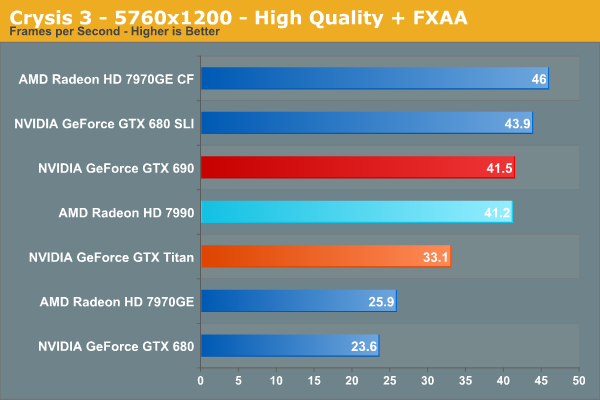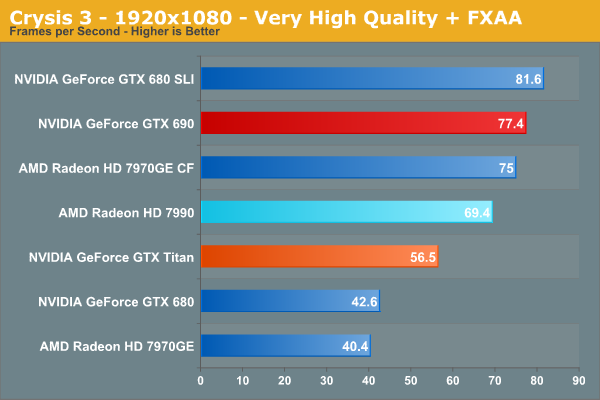AMD Radeon HD 7990 Review: 7990 Gets Official
by Ryan Smith on April 24, 2013 12:01 AM EST- Posted in
- GPUs
- AMD
- Radeon
- Radeon HD 7000
- Tahiti
Crysis 3
Our final benchmark in our suite needs no introduction. With Crysis 3, Crytek has gone back to trying to kill computers, taking back the “most punishing game” title in our benchmark suite. Only in a handful of setups can we even run Crysis 3 at its highest (Very High) settings, and that’s still without AA. Crysis 1 was an excellent template for the kind of performance required to driver games for the next few years, and Crysis 3 looks to be much the same for 2013.



If the concept of karma exists for GPUs, then it would seem to be in full force here. While AMD has an easy time pulling ahead of NVIDIA’s cards in Crysis 1, in Crysis 3 it’s almost exactly the opposite. At both 1920 and 2560 the 7990 trails the GT 690 by around 10%, only to finally pull even at 5760 thanks to AMD’s better multi-monitor handling.
Meanwhile it’s interesting to note just how much rendering performance it takes to feed the beast that is Crysis 3. With everything turned up short of anti-aliasing, the mighty 7990 is the bare minimum needed to clear 60fps at 1920, and Very High quality is out of the question at 2560 and higher. It will probably be another year or two before we have a single cards that can smoothly play Crysis 3 at its highest settings; in the meantime it will take multiple high-end cards to make that happen.










91 Comments
View All Comments
HisDivineOrder - Wednesday, April 24, 2013 - link
They bring a fantastic cooler that prioritizes silence and convenience to have SLI in a system that doesn't have two PCIe slots available for them. Plus, you always had the option of quad-SLI that's a little harder to do with four 680's.That said, I think anyone buying a 690 over a Titan now is pretty stupid. It's not about the speed difference. It's that if you're in the market for a $1k GPU, go for the one that won't be running out of memory with next year's PS4/next Xbox ports.
extremesheep - Wednesday, April 24, 2013 - link
Table typo...should the first be "7990"?extremesheep - Wednesday, April 24, 2013 - link
Err...should page 1, table 1, column 1 be "7990" instead of "7970"?Ryan Smith - Wednesday, April 24, 2013 - link
You may be seeing an old, cached copy. That was fixed about 25 minutes ago.code65536 - Wednesday, April 24, 2013 - link
Any chance we could get Tomb Raider in future benchmark tests?Ryan Smith - Wednesday, April 24, 2013 - link
In the desktop tests? No. We keep the tests capped at 10 so that it's a manageable load when we need to redo everything, such as with the 7990 launch. At this point the desktop benchmark suite is set for at least the immediate future.VulgarDisplay - Wednesday, April 24, 2013 - link
4th paragraph: Incorrectly stated that Tahiti has 48 rops.Flamencor - Wednesday, April 24, 2013 - link
What a mediocre review! In your conclusions, you mention nothing about how AMD absolutely spanked NVIDIA in compute performance and synthetics! It is 75 watts more power hungry, and in exchange you get substantially more memory and a total win on compute and synthetics! I know synthetics aren't actual gaming numbers, but they're indicative of how the card will stand up to future games. The fact that the card has far better synthetics says a lot about it's longevity. The card looks like a great card (although quite late)! I'm no fanboy, but why can't people just write a legitimately upbeat and positive review about an amazing part?Warren21 - Wednesday, April 24, 2013 - link
Ryan typically has a slight undertone of NVIDIA bias; it can be found in most of his articles. That being said, the GTX 600 series are some amazing cards. I'd love to have a GK104-based card to replace my aged 6870 1GB.CiccioB - Wednesday, April 24, 2013 - link
This kind of compute benchmarks based on OpenCL are quite useless. No professional applications use OpenCL and nvidia doesn't really put all its efforts in optimizing their OpenCL drivers.You may be surprise to know that REAL applications that really need GPU assisted computation use CUDA. And thus you have the option to use nvidia GPU computation or nothing else.
That's for how good is OpenCL. It may be open, it may be something AMD needs to show good (useless) graphs, but in real word none is going to use it for serious stuff.
3D renderers are a meaningful example: apart the useless SmallLuxMark benchmark, professional engines use CUDA. AMD is not there with whatever "devasting" computational solution you may believe they have. That's why nvidia holds more than 80% of the professional market and it's the only one having GPUs solutions for HPC while AMD just struggles to sell consumer products.
By the way, goo review, though a double Titan solution may have been added to make it more interesting (especially for power consumption) :)